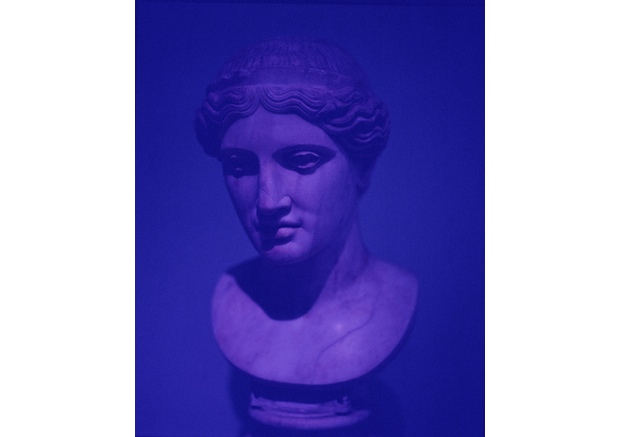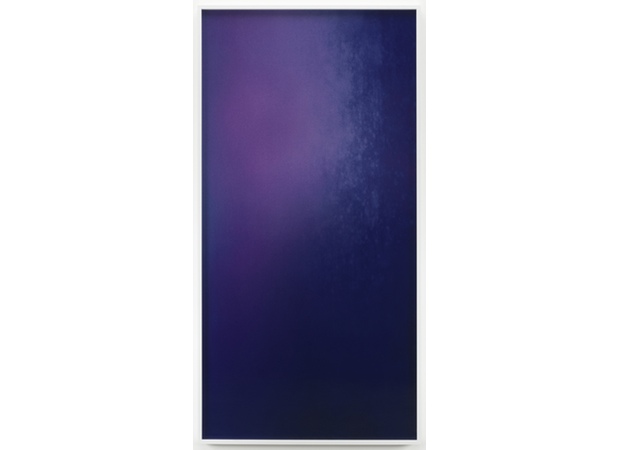Interview with Sara VanDerBeek
For her first solo exhibition at Metro Pictures, on view through June 8, New York–based artist Sara VanDerBeek made photographs at museums of antiquity and archeological sites in several European cities. These images have been given unique frames and are paired with cast-concrete sculptures similar to those VanDerBeek photographed for her earlier work. Brian Sholis, who wrote about VanDerBeek’s work in Aperture #202, spoke with the artist by phone.
Brian Sholis: In recent years you’ve made work in several US cities—Detroit, New Orleans, and your hometown, Baltimore. What are some of the differences you noticed when working in cities like Paris, Rome, and Naples?
Sara VanDerBeek: One big difference was in the way I navigated them. In America I chose to walk around and respond to the outdoor environment. I chose sites and spaces that resonated with the life of the city, or an impactful event in its recent past; for example, I made images of building foundations in the Lower Ninth Ward in New Orleans. But in Europe I worked mostly indoors, in various museums and collections. I’m not sure whether my familiarity with American cities allowed me to explore them with more confidence, or whether it was in part because I traveled to Europe with the specific purpose of exploring some of these pre-eminent collections of sculpture.
I will say, however, that I feel like history—as a larger, more abstract idea, as something taught and learned—suffuses European cities and museums, whereas a more specific and tangible history is present in the surfaces of American cities. That’s part of why I chose to focus on the ancient and neo-classical sculptures that are the subjects of some of the photographs in this exhibition. I wanted to explore figures that are already iconographic. Although they are three-dimensional, I think of them almost as images. I did engage and connect with the contemporary life of these European cities—I met and befriended a number of young artists and curators, and was very intrigued by their perspective on both the current and historical nature of their cities. But something about this whole endeavor led me to become focused on certain aspects of the past as they connected to the present. As I was photographing these sculptures and visiting different sites, I considered the changing depictions of the body, and how those depictions reflected larger changes in the cultures of their creation. The repetition of the figures was very intriguing to me, too. Most of all, I was interested in discovering, through the arrangement of the objects and the images in the show, a way to create an experience that in some way translated my original experience of visiting these sites.
BJS: Were you cognizant of being under the spell of these environments? Did you try to respond to them in terms other than those handed to you by art history books?
SV: I think “under the spell” is a good phrase. I was very inspired, or even mesmerized, at times. Sometimes the environments were dreamlike; at the very least they are different from what I have experienced of American institutions. Smaller collections in Rome, for example, allowed me extended time alone with the objects. I felt a connection to these figures, could begin to make sense of their gravitational force; I was able to move around them and study them intently. I was able to slow down, and I spent lots of time with each object so that my idea of them was formed out of direct observation and the camera’s view.
BJS: You also were not encumbered with a lot of equipment.
SV: I had a camera, but no tripod, and I used existing light. I tried to embrace the specific qualities of the objects emphasized by their environments, to understand how they were lit and staged. The tableaux are fascinating. However, after working in the museums, I did a lot of things during the printing and framing processes to alter the colors in the imagery, to try and re-create the imaginative, dreamlike way I experienced them.
I really enjoy the simplicity of this way of working. It was just me, with my camera, out in the world—I was trying to be present in the moment. This initial phase is the most exciting and invigorating part of the process; it’s when I get the ideas from which everything evolves, the sculptures, the overall installation, and the quality I hope to achieve in the final printed image.

Sara VanDerBeek, Roman Woman I, 2013. Courtesy of the artist and Metro Pictures, New York.
BJS: Let’s talk briefly about the presentation at Metro Pictures. The show marks the first time you’ve exhibited a large number of your sculptures in New York. You have also made very specific decisions regarding framing. The show can be understood as an exploration of the relationship between images and objects. Though you were working simply, you are not presenting straight, “documentary” photographs.
SV: When I began exhibiting the sculptures I had previously used only for my studio-based photographs, I was encouraged to further consider the photograph as an object. I have often thought about how prints themselves fluctuate between image and object, and I wanted my photographs to have some other, possibly three-dimensional quality.
I had been exploring these questions during the last year, but hadn’t worked out the details until I began thinking about how classical sculptures had at one point been painted. They were themselves a meeting of image and object. The paint, its colors, was a means of communication, a literal and symbolic adornment. Today we see these figures without most of their color. They have changed over time, and to see them now is to be able to contemplate those differences.
Coloring the photographs by placing them behind semitransparent Plexiglas emulates the original act of coloring the sculptures. The Plexiglas I chose is quite a dark, deep blue. The figures become more like shapes or apparitions; they are semi-abstract textures and forms, though still legible as figures. I have also used mirrored glass for the larger, abstract photographs I’m presenting in one room at Metro Pictures. With them I’m trying to create a fleeting, ephemeral experience, one that mirrors what I felt while trying to capture particular moments in these sites. I wanted images that would change and fluctuate. Your reflection in the mirrored glass does that, but the color and texture you can see behind it will change, too. I keep going back to notions of dreams, of dreamlike images. Dreams, too, are specific but not fixed.
BJS: You mentioned earlier that this careful calibration of works in Metro Pictures’s three separate galleries is an attempt, on some level, to re-create your experience of these museum collections in Europe. Can you explain that further?
SV: I tried to take into account shifts in scale, and the viewer’s relationship to the objects and photographs as he or she moves through the galleries. Some objects are composed of human-scale modules, while other sculptures are a little bit larger than human scale, as were the figures I saw in Naples, at the National Archeological Museum. I was surprised to discover how large some of the classical sculptures were—in particular the figures that had adorned the Baths of Caracalla in Rome. I had never seen classical figures that large, and I hope that in my exhibition you get a sense of the proportion and mass that I felt when viewing these sculptures, as well as the quality and changes in your sense of scale as you move around them.
I have always been interested in how photography affects the reading of scale, time, and place. It can be disorienting or confusing to encounter a photograph of something, but it can also usefully enlighten some little-perceived aspect of real-life experience.

Sara VanDerBeek, Metal Mirror I (Magia Naturalis), 2013. Courtesy of the artist and Metro Pictures, New York.
BJS: It was sometimes difficult to discern the actual size of the studio-based constructions you photographed earlier in your career. Can you speak about the contrasts between your early work, which was primarily in the studio, and your recent work, which has mostly taken place out in the world?
SV: I enjoy mixing different ways of working. Working out in the world involves a level of reactiveness, of being open to chance, that wasn’t as much a part of my earlier practice. When shooting in these European museums and gardens I was moving fairly quickly, responding to the qualities of light I encountered. Despite this dependence on context, the process can be as gestural as creating and staging tableaux in the studio. And it has changed my work in the studio, as well. Today when I create still lifes in the studio, I often work with natural light, shoot fewer frames. And I’m more open to trying alternate vantage points. For the early photographs of layered assemblages, made circa 2005 or 2006, I would shoot rolls and rolls of film. I’ve become a little bit more focused now, and I think that has come from lessons learned while shooting out in the world.
The studio now functions for me in a manner similar to my understanding of these classical figures: it’s a meeting point of different times. I take images, print them out, bring them into the studio, and consider them alongside sculptures or other, earlier photographs—it creates a “still life” of various pasts in the present. We all recognize that the present is imbued with the past; what I hope is that the exhibition itself communicates a sense of the feedback loops I experience while working, whereby sculptures generate images and images generate sculptures. That loop is itself a metaphor for the continually evolving process of thinking, making, and interpretation that is any artist’s or individual’s experience in life. We are continually trying to understand and process our past as we address ongoing issues. I feel these works are representative of that kind of grappling, of coming to terms with the foundations on which we build.























